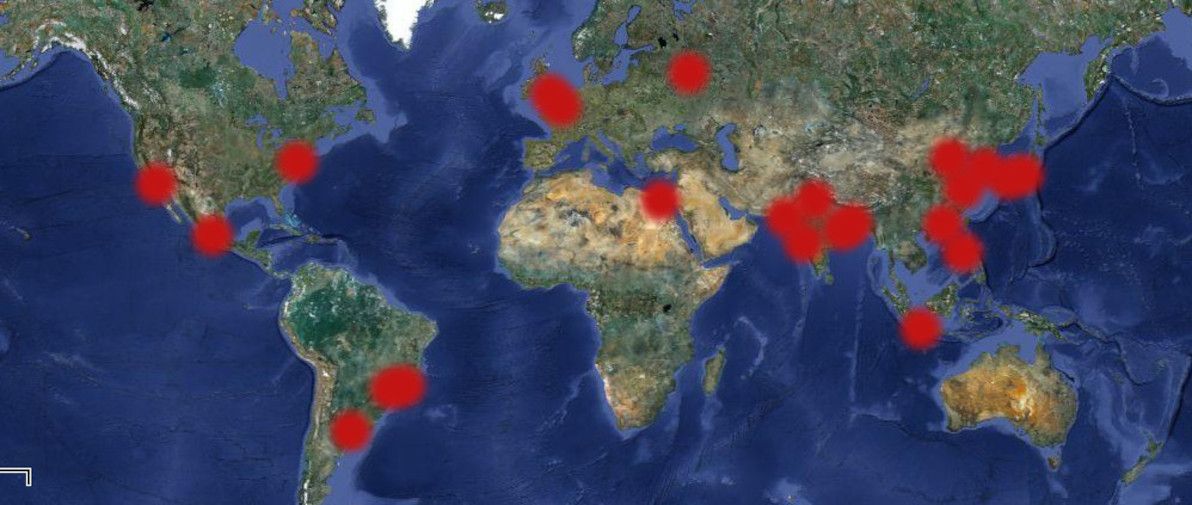It's no secret that Hollywood is the entertainment capital of the world. Hollywood blockbuster movies are among the most influential cultural works in the history of humanity. This got me thinking: exactly how many corners of the globe have American movies spread to; and to what extent have they come to dominate entertainment in all those places? Also, is Hollywood really as all-powerful a global cinema force as we believe; or does it have some bona fide competition these days?
I spent a bit of time recently, hunting for sets of data that could answer these questions in an expansive and meaningful way. And I'm optimistic that what I've come up with satisfies both of those things: in terms of expansive, I've got stats (admittedly of varying quality) for most of the film-watching world; and in terms of meaningful, I'm using box office admission numbers, which I believe are the most reliable international measure of film popularity.
So, without further ado, here are the stats that I've come up with:
| Country |
Admissions (millions) |
US admissions (percent of total) |
EU admissions (percent of total) |
Local admissions (percent of total) |
Other admissions (percent remainder) |
| India |
2,900.0
Gross (millions): $1,860.0
Year: 2009
|
6.0%
US admissions (millions): 174.0
US admissions notes: based on 2007 figures.
|
0.8%
EU admissions (millions): 23.2
EU admissions notes: based on 2007 figures.
|
92.0%
Local admissions (millions): 2,668.0
Local admissions notes: 2009 figures.
|
1.2%
|
| US |
1,364.0
Gross (millions): $9,360.0
Year: 2009
|
91.5%
US admissions (millions): 1,248.1
US admissions notes: 2008 figures.
|
7.2%
EU admissions (millions): 98.2
EU admissions notes: 2008 figures.
|
n/a
|
1.3%
|
| China |
217.8
Gross (millions): $906.3
Year: 2009
|
38.0%
US admissions (millions): 82.8
US admissions notes: Based on total admissions for US movies in top 10 admissions in country.
|
4.0%
EU admissions (millions): 8.7
EU admissions notes: Based on total admissions for EU movies in top 10 admissions in country.
|
56.6%
Local admissions (millions): 123.3
Local admissions notes: 2009 figures.
|
1.4%
|
| France |
200.9
Gross (millions): $1,710.0
Year: 2009
|
49.8%
US admissions (millions): 100.0
US admissions notes: 2007 figures.
|
50.2%
EU admissions (millions): 100.9
EU admissions notes: 2007 figures.
|
n/a
|
0.0%
|
| Mexico |
178.0
Gross (millions): $562.5
Year: 2009
|
90.0%
US admissions (millions): 160.2
US admissions notes: Based on total admissions for US movies in top 10 admissions in country.
|
1.0%
EU admissions (millions): 1.8
EU admissions notes: Based on total admissions for EU movies in top 10 admissions in country.
|
7.5%
Local admissions (millions): 13.4
Local admissions notes: 2009 figures.
|
1.5%
|
| UK |
173.5
Gross (millions): $1,470.0
Year: 2009
|
77.0%
US admissions (millions): 133.6
US admissions notes: Based on 2008 figures.
|
21.5%
EU admissions (millions): 37.3
EU admissions notes: Based on 2008 figures.
|
n/a
|
1.5%
|
| Japan |
169.3
Gross (millions): $2,200.0
Year: 2009
|
38.0%
US admissions (millions): 64.3
US admissions notes: Based on total admissions for US movies in top 20 admissions in country.
|
2.0%
EU admissions (millions): 3.4
EU admissions notes: Based on total admissions for EU movies in top 20 admissions in country.
|
56.9%
Local admissions (millions): 96.3
Local admissions notes: 2009 figures.
|
1.5%
|
| South Korea |
156.8
Gross (millions): $854.4
Year: 2009
|
46.0%
US admissions (millions): 72.1
US admissions notes: Based 2008 figures.
|
2.5%
EU admissions (millions): 3.9
EU admissions notes: Based on 2008 figures.
|
48.8%
Local admissions (millions): 76.5
Local admissions notes: 2009 figures.
|
2.7%
|
| Germany |
146.3
Gross (millions): $1,360.0
Year: 2009
|
65.0%
US admissions (millions): 95.1
US admissions notes: Based on total admissions for US movies in top 20 admissions in country.
|
34.4%
EU admissions (millions): 50.3
EU admissions notes: Based on total admissions for EU movies in top 20 admissions in country.
|
n/a
|
0.6%
|
| Russia & CIS |
138.5
Gross (millions): $735.7
Year: 2009
|
60.0%
US admissions (millions): 83.1
US admissions notes: Based on total admissions for US movies in top 20 admissions in country.
|
12.0%
EU admissions (millions): 16.6
EU admissions notes: Based on total admissions for EU movies in top 20 admissions in country.
|
23.9%
Local admissions (millions): 33.1
Local admissions notes: 2009 figures.
|
4.1%
|
| Brazil |
112.7
Gross (millions): $482.9
Year: 2009
|
75.0%
US admissions (millions): 84.5
US admissions notes: Based on total admissions for US movies in top 10 admissions in country.
|
10.0%
EU admissions (millions): 11.3
EU admissions notes: Based on total admissions for EU movies in top 10 admissions in country.
|
14.3%
Local admissions (millions): 16.1
Local admissions notes: 2009 figures.
|
0.7%
|
| Italy |
111.2
Gross (millions): $940.0
Year: 2009
|
64.0%
US admissions (millions): 71.2
US admissions notes: Based on total admissions for US movies in top 20 admissions in country.
|
29.4%
EU admissions (millions): 32.7
EU admissions notes: Based on total admissions for EU movies in top 20 admissions in country.
|
n/a
|
6.6%
|
| Spain |
109.5
Gross (millions): $928.5
Year: 2009
|
65.0%
US admissions (millions): 71.2
US admissions notes: Based on total admissions for US movies in top 20 admissions in country.
|
32.0%
EU admissions (millions): 35.0
EU admissions notes: Based on total admissions for EU movies in top 20 admissions in country.
|
n/a
|
3.0%
|
| Canada |
108.0
Gross (millions): $863.0
Year: 2009
|
88.5%
US admissions (millions): 95.6
US admissions notes: 2008 figures.
|
8.0%
EU admissions (millions): 8.6
EU admissions notes: 2008 figures.
|
2.8%
Local admissions (millions): 3.0
Local admissions notes: 2009 figures.
|
0.7%
|
| Australia |
90.7
Gross (millions): $848.4
Year: 2009
|
84.2%
US admissions (millions): 76.4
US admissions notes: 2008 figures.
|
10.0%
EU admissions (millions): 9.1
EU admissions notes: 2008 figures.
|
5.0%
Local admissions (millions): 4.5
Local admissions notes: 2009 figures.
|
0.8%
|
| Philippines |
65.4
Gross (millions): $113.8
Year: 2008
|
80.0%
US admissions (millions): 52.3
US admissions notes: Based on total gross for US movies in top 100 movies in country.
|
4.0%
EU admissions (millions): 2.6
EU admissions notes: Based on total gross for EU movies in top 100 movies in country.
|
15.0%
Local admissions (millions): 9.8
Local admissions notes: General estimate based on number of local films made.
|
1.0%
|
| Indonesia |
50.1
Gross (millions): $102.2
Year: 2008
|
80.0%
US admissions (millions): 40.1
US admissions notes: Based on total gross for US movies in top 100 movies in country.
|
4.0%
EU admissions (millions): 2.0
EU admissions notes: Based on total gross for EU movies in top 100 movies in country.
|
15.0%
Local admissions (millions): 7.5
Local admissions notes: General estimate based on number of local films made.
|
1.0%
|
| Malaysia |
44.1
Gross (millions): $114.1
Year: 2009
|
82.0%
US admissions (millions): 36.2
US admissions notes: Based on total gross for US movies in top 100 movies in country.
|
4.0%
EU admissions (millions): 1.8
EU admissions notes: Based on total gross for EU movies in top 100 movies in country.
|
13.7%
Local admissions (millions): 6.0
Local admissions notes: 2009 figures.
|
0.3%
|
| Poland |
39.2
Gross (millions): $218.1
Year: 2009
|
70.0%
US admissions (millions): 27.4
US admissions notes: Based on total admissions for US movies in top 10 admissions in country.
|
29.5%
EU admissions (millions): 11.6
EU admissions notes: Based on total admissions for EU movies in top 10 admissions in country.
|
n/a
|
0.5%
|
| Turkey |
36.9
Gross (millions): $198.0
Year: 2009
|
42.0%
US admissions (millions): 15.5
US admissions notes: 2009 figures.
|
6.0%
EU admissions (millions): 2.2
EU admissions notes: Based on total admissions for EU movies in top 10 admissions in country.
|
50.9%
Local admissions (millions): 18.8
Local admissions notes: 2009 figures.
|
1.1%
|
| Argentina |
33.3
Gross (millions): $126.1
Year: 2009
|
76.0%
US admissions (millions): 25.3
US admissions notes: Based on total admissions for US movies in top 10 admissions in country.
|
7.0%
EU admissions (millions): 2.3
EU admissions notes: Based on total admissions for EU movies in top 10 admissions in country.
|
16.0%
Local admissions (millions): 5.3
Local admissions notes: 2009 figures.
|
1.0%
|
| Netherlands |
27.3
Gross (millions): $279.5
Year: 2009
|
65.0%
US admissions (millions): 17.7
US admissions notes: Based on total admissions for US movies in top 10 admissions in country.
|
33.4%
EU admissions (millions): 9.1
EU admissions notes: Based on total admissions for EU movies in top 10 admissions in country.
|
n/a
|
1.6%
|
| Colombia |
27.3
Gross (millions): $91.7
Year: 2009
|
82.0%
US admissions (millions): 22.4
US admissions notes: Based on total admissions for US movies in top 10 admissions in country.
|
10.0%
EU admissions (millions): 2.7
EU admissions notes: Based on total admissions for EU movies in top 10 admissions in country.
|
4.8%
Local admissions (millions): 1.3
Local admissions notes: 2009 figures.
|
3.2%
|
| Thailand |
27.1
Gross (millions): $101.3
Year: 2008
|
60.0%
US admissions (millions): 16.3
US admissions notes: Based on total gross for US movies in top 100 movies in country.
|
1.0%
EU admissions (millions): 0.3
EU admissions notes: Based on total gross for EU movies in top 100 movies in country.
|
37.5%
Local admissions (millions): 10.2
Local admissions notes: 2009 figures.
|
1.5%
|
| South Africa |
26.1
Gross (millions): $52.3
Year: 2008
|
72.0%
US admissions (millions): 18.8
US admissions notes: Based on total gross for US movies in top 100 movies in country.
|
10.0%
EU admissions (millions): 2.6
EU admissions notes: Based on total gross for EU movies in top 100 movies in country.
|
15.0%
Local admissions (millions): 3.9
Local admissions notes: General estimate based on number of local films made.
|
3.0%
|
| Egypt |
25.6
Gross (millions): $54.9
Year: 2009
|
16.0%
US admissions (millions): 4.1
US admissions notes: Based on total gross for US movies in top 100 movies in country.
|
2.0%
EU admissions (millions): 0.4
EU admissions notes: Based on total gross for EU movies in top 100 movies in country.
|
80.0%
Local admissions (millions): 20.5
Local admissions notes: 2009 figures.
|
2.0%
|
| Taiwan |
23.6
Gross (millions): $172.3
Year: 2009
|
75.0%
US admissions (millions): 17.7
US admissions notes: Based on total gross for US movies in top 100 movies in country.
|
2.0%
EU admissions (millions): 0.5
EU admissions notes: Based on total gross for EU movies in top 100 movies in country.
|
22.3%
Local admissions (millions): 5.3
Local admissions notes: 2009 figures (including Chinese films).
|
0.7%
|
| Belgium |
22.6
Gross (millions): $187.3
Year: 2009
|
60.0%
US admissions (millions): 13.6
US admissions notes: Based on total gross for US movies in top 100 movies in country.
|
37.9%
EU admissions (millions): 8.6
EU admissions notes: Based on total gross for EU movies in top 100 movies in country.
|
n/a
|
2.1%
|
| Singapore |
22.0
Gross (millions): $115.3
Year: 2009
|
90.0%
US admissions (millions): 19.8
US admissions notes: Based on total admissions for US movies in top 10 admissions in country.
|
3.0%
EU admissions (millions): 0.7
EU admissions notes: Based on total admissions for EU movies in top 10 admissions in country.
|
3.8%
Local admissions (millions): 0.9
Local admissions notes: 2009 figures.
|
3.2%
|
| Venezuela |
22.0
Gross (millions): $163.6
Year: 2008
|
90.0%
US admissions (millions): 19.8
US admissions notes: Based on total admissions for US movies in top 10 admissions in country.
|
6.0%
EU admissions (millions): 1.3
EU admissions notes: Based on total admissions for EU movies in top 10 admissions in country.
|
0.6%
Local admissions (millions): 0.1
Local admissions notes: 2009 figures.
|
3.4%
|
| Hong Kong |
20.1
Gross (millions): $152.2
Year: 2008
|
70.0%
US admissions (millions): 14.1
US admissions notes: Based on total admissions for US movies in top 10 admissions in country.
|
3.0%
EU admissions (millions): 0.6
EU admissions notes: Based on total admissions for EU movies in top 10 admissions in country.
|
21.0%
Local admissions (millions): 4.2
Local admissions notes: 2009 figures.
|
6.0%
|
Note: this table lists all countries with annual box office admissions of more than 20 million tickets sold. The countries are listed in descending order of number of box office admissions. The primary source for the data in this table (and for this article in general), is the 2010 edition of the FOCUS: World Film Market Trends report, published by the European Audiovisual Observatory.
The Mighty Hollywood
Before I comment on anything else, I must make the point loudly and clearly: Hollywood is still the most significant cinema force in the world, as it has consistently been since the dawn of movie-making over a century ago. There can be no denying that. By every worldwide cinema-going measure, movies from the United States are still No. 1: quantity of box office tickets sold; gross box office profit; and extent of geopolitical box office distribution.
The main purpose of this article, is to present the cinema movements around the world that are competing with Hollywood, and to demonstrate that some of those movements are significant potential competition for Hollywood. I may, at times in this article, tend to exaggerate the capacity of these regional players. If I do, then please forgive me, and please just remind yourself of the cold, harsh reality, that when Hollywood farts, the world takes more notice than when Hollywood's contenders discover life on Mars.
Seriously, Hollywood is mighty
Having made my above point, let's now move on, and have a look at the actual stats that show just how frikkin' invincible the USA's film industry is today:
- The global distribution of US movies is massive: of the 31 countries listed in the table above, 24 see more than 50% of their box office admissions being for US movies.
- The US domestic cinema industry is easily the most profitable in the world, raking in more than US$9 billion annually; and also the most extensive in the world, with almost 40,000 cinema screens across the country (2009 stats).
- The US film industry is easily the most profitable in the world: of the 20 top films worldwide by gross box office, all of them are at least partly Hollywood-produced; and of those, 13 are 100% Hollywood-produced.
Cinéma Européen
In terms of global distribution, and hence also in terms of global social and cultural impact, European movies quite clearly take the lead, after Hollywood (of course). That's why, in the table above, the only two film industries whose per-country global box office admissions I've listed, are those of the United States and of the European Union. The global distribution power of all the other film industries is, compared to these two heavyweights, negligible.
Within the EU, by far the biggest film producer — and the most successful film distributor — is France. This is nothing new: indeed, the world's first commercial public film screening was held in Paris, in 1895, beating New York's début by a full year. Other big players are Germany, Spain, Italy, and the UK. While the majority of Joe Shmoe cinema-goers worldwide have always craved the sex, guns and rock 'n' roll of Hollywood blockbusters, there have also always been those who prefer a more cultured, refined and sophisticated cinema experience. Hence, European cinema is — while not the behemoth that is Hollywood — strong as ever.
France is the only country in Europe — or the world — where European films represent the majority of box office admissions; and even in France, they just scrape over the 50% mark, virtually tied with Hollywood admissions. In the other European countries listed in the table above (UK, Germany, Italy, Spain, Poland, Netherlands, and Belgium), EU admissions make up around 30-35% of the market, with American films taking 60-75% of the remaining share. In the rest of the world, EU admissions don't make it far over the 10% mark; although their share remains significant worldwide, with 24 of the 31 countries in the table above having 3% or more EU admissions.
Oh My Bollywood!
You may have noticed that in the table, the US is not first in the list. That's because the world's largest cinema-going market (in terms of ticket numbers, not gross profit) is not the US. It's India. Over the past several decades, Bollywood has risen substantially, to become the second-most important film industry in the world (i.e. it's arguably more important than the European industry).
India has over 1.2 billion people, giving it the second-largest population in the world (after China). However, Indians love cinema much more than the Chinese do. India has for quite some time been the world's No. 1 producer of feature films. And with 2.9 billion box office admissions annually, the raw cinema-going numbers for India are more than double those of the US, which follows second worldwide.
Apart from being No. 1 in domestic box office admissions, India also has the highest percentage of admissions for local films, and the lowest percentage of admissions for US films, in the world. That means that when Indians go to the cinema, they watch more local movies, and less American movies, than any other people in the world (exactly what the social and cultural implications of that are, I leave for another discussion — perhaps better analysed in a PhD thesis than in a blog post!). That also gives Bollywood the No. 2 spot for international box office admissions.
However, massive as Bollywood's presence and its influence is domestically within India (and in the rest of South Asia), its global reach is pretty slim. Bollywood's No. 2 spot for international box office admissions, stems 99% from its domestic admissions. The vast majority of Bollywood movies are never even shipped outside of the region, let alone screened in cinemas. A significant number are also filmed in the Hindi language, and are never dubbed or subtitled in English (or any other languages), due to lack of an international market.
There are some exceptions. For example, a number of Bollywood films are distributed and screened in cinemas in the UK, targeting the large Indian community there (the number of films is relatively small compared to the size of the Bollywood industry, but it's a significant number within the UK cinema market). However, despite its growing international fame, Bollywood remains essentially a domestic affair.
The rest of the world has yet to truly embrace the lavish psychedelic costumes; the maximum interval of six minutes between twenty-minute-long, spontaneous, hip-swinging, sari-swirling song-and-dance routines; or the idea that the plot of every movie should involve a poor guy falling in love with a rich girl whose parents refuse for them to marry (oh, and of course there must also be a wedding, and it must be the most important and extravagent scene of the movie). Bollywood — what's not to love?
Nollywood, anyone?
We're all familiar with Bollywood… but have you heard of Nollywood? It's the film industry of Nigeria. And, in case you didn't know, in the past decade or so Nollywood has exploded from quite humble beginnings, into a movement of epic proportions and of astounding success. In 2009, Nollywood rose up to become the No. 2 producer of feature films in the world (second only to the Indian industry, and pushing Hollywood down to third place).
However, you may have noticed that Nigeria isn't in the table above at all. That's because cinema screens in Nigeria are few and far between, and almost all Nollywood films are released straight to home media (formerly VHS, these days DVD). So, Nollywood is an exceptional case study here, because the focus of this article is to measure the success of film industries by box office admissions; and yet Nollywood, which has rapidly become one of the most successful film industries in the world, lacks almost any box office admissions whatsoever.
There are few hard statistics available for distribution of films within Nigeria (or in most of the rest of Africa), in terms of box office admissions, DVD sales (with almost all being sold in ramshackle markets, and with many being pirated copies), or anything else. However, the talk of the town is that the majority of movies watched in Nigeria, and in many other countries in Africa, are local Nollywood flicks. In Nigeria itself, the proportion of local-vs-Hollywood film-watching may even be reaching Indian levels, i.e. more than 90% of viewings being of local films — although it's impossible to give any exact figures.
Nollywood's distribution reach is pretty well limited to domestic Nigeria, and the surrounding African regions. Bollywood boasts a significantly greater international distribution… and Bollywood's reach ain't amazing, either. The low-budget production and straight-to-disc distribution strategies of Nollywood have proved incredibly successful locally. However, this means that most Nollywood movies aren't even suitable for cinema projection without serious editing (in terms of technology and cinematography), and this has probably been a factor in limiting Nollywood's growth in other markets, where traditional box office distribution is critical to success.
East Asian cinema
The film industries of the Orient have always been big. In particular, the industries of China and Japan, respectively, are each only slightly behind Hollywood in number of feature films produced annually (and Korea is about on par with Italy). Many East Asian film industries enjoy considerable local success, as evidenced in the table above, where several Asian countries are listed as having a significant percentage of local box office admissions (in China, Japan and Korea, local films sweep away 50% or more of the box office admissions).
Much like Bollywood, the film industries of many East Asian countries have often fallen victim to cliché and "genre overdose". In China and Hong Kong, the genre of choice has long been martial arts, with Kung Fu movies being particularly popular. In Japan and Korea, the most famous genre traditionally has been horror, and in more recent decades (particularly in Japan), the anime genre has enjoyed colossal success.
East Asian film is arguably the dominant cultural film force within the region (i.e. dominant over Hollywood). It's also had a considerable influence on the filmmaking tradition of Hollywood, with legends such as Japan's Akira Kurosawa being cited by numerous veteran Hollywood directors, such as Martin Scorsese.
However, well-established though it is, the international distribution of East Asian films has always been fairly limited. Some exceptional films have become international blockbusters, such as the (mainly) Chinese-made Crouching Tiger, Hidden Dragon (2000). Japanese horror and anime films are distributed worldwide, but they have a cult following rather than a mainstream appreciation in Western countries. When most Westerners think of "Asian" movies, they most likely think of Jackie Chan and Bruce Lee, the majority of whose films were Hollywood productions. Additionally, the international distribution of movies from other strong East Asian film industries, such as those of Thailand and Taiwan, is almost non-existent.
Middle Eastern cinema
The most significant player in Middle Eastern cinema is Egypt, which has a long and glorious film-making tradition. The Egyptian film industry accounts for a whopping 80% of Egypt's domestic box office admissions; and, even more importantly, Egyptian films are exported to the rest of the Arabic-speaking world (i.e. to much of the rest of the Middle East), and (to some extent) to the rest of the Muslim world.
Turkey is also a cinema powerhouse within the Middle East. Turkey's film industry boasts 51% of the local box office admissions, and Turkey as a whole is the largest cinema-going market in the region. The international distribution of Turkish films is, however, somewhat more limited, due to the limited appeal of Turkish-language cinema in other countries.
Although it's not in the table above, and although limited data is available for it, Iran is the other great cinema capital of the region. Iran boasted a particularly strong film industry many decades ago, before the Islamic Revolution of 1979; nevertheless, the industry is still believed to afford significant local market share today.
Also of note is Israel, which is the most profitable cinema-going market in the region after Turkey, and which supports a surprisingly productive and successful film industry (with limited but far-reaching international distribution), given the country's small population.
Other players worldwide
- Russia & CIS. Although US box office admissions dominate these days, the Russian film industry wins almost 25% of admissions. This is very different to the Soviet days, when foreign films were banned, and only state-approved (and highly censored) films were screened in cinemas. Russian movies are mainly distributed within the former Soviet Union region, although a small number are exported to other markets.
- Latin America. The largest markets for box office admissions in the region are Mexico, Brazil, and Argentina. Admissions in all of Latin America are majority Hollywood; however, in these "big three", local industries are also still quite strong (particularly in Brazil and Argentina, each with about 15% local admissions; about half that number in more US-dominated Mexico). Local industries aren't as strong as they used to be, but they're still most definitely alive. Latin American films are distributed and screened worldwide, although their reception is limited. There have been some big hits, though, in the past decade: Mexico's Amores Perros (2000); Argentina's Nueve Reinas (2000); and Brazil's Cidade de Deus (2002).
- South Africa. Despite having a fairly large box office admission tally, there's not a whole lot of data available for local market share in the South African film industry. Nevertheless, it is a long-established film-making country, and it continues to produce a reasonable number of well-received local films every year. South Africa distributes films internationally, although generally not with blockbuster success — but there have been exceptions, e.g. Tsotsi (2005).
In summary
If you've made it this far, you must be keen! (And this article must be at least somewhat interesting). Sorry, this has turned out to be a bit longer than average for a thought article; but hey, turns out there are quite a lot of strong film industries around the world, and I didn't want to miss any important ones.
So, yes, Hollywood's reach is still universal, and its influence not in any way or in any place small. But no, Hollywood is not the only force in this world that is having a significant cultural effect, via the medium of the motion picture. There are numerous other film industries today, that are strong, and vibrant, and big. Some of them have been around for a long time, and perhaps they just never popped up on the ol' radar before (e.g. Egypt). Others are brand-new and are taking the world by storm (e.g. Nollywood).
Hollywood claims the majority of film viewings in many countries around the world, but not everywhere. Particularly, on the Indian Subcontinent (South Asia), in the Far East (China, Japan, Korea), and in much of the Middle East (Egypt, Turkey, Iran), the local film industries manage to dominate over Hollywood in this regard. Considering that those regions are some of the most populous in the world, Hollywood's influence may be significantly less than many people like to claim.
But, then again, remember what I said earlier: Hollywood farts, whole world takes notice; film-makers elsewhere discover life on Mars, doesn't even make the back page.
Additional references
]]>















